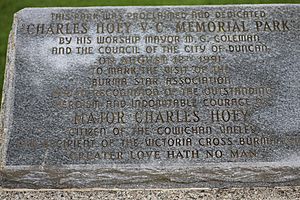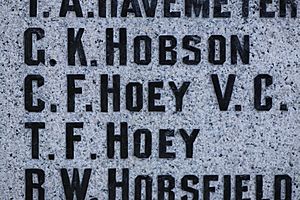Charles Ferguson Hoey facts for kids
Quick facts for kids
Charles Ferguson Hoey
|
|
|---|---|
 |
|
| Born | 29 March 1914 Duncan, British Columbia |
| Died | 16 February 1944 (aged 29) Ngakyedauk Pass, Admin Box, Arakan, British Burma |
| Buried |
Taukkyan War Cemetery, Rangoon, Burma
|
| Allegiance | |
| Service/ |
|
| Years of service | 1936 - 1944 |
| Rank | Major |
| Service number | 71106 |
| Unit | Lincolnshire Regiment |
| Battles/wars | Second World War |
| Awards | |
Major Charles Ferguson Hoey was a brave Canadian soldier. He received the Victoria Cross (VC) and the Military Cross (MC). The Victoria Cross is the highest award for bravery in battle. It is given to soldiers from the United Kingdom and Commonwealth countries. Charles Hoey was born on March 29, 1914, and died on February 16, 1944.
Contents
Becoming a Soldier: Charles Hoey's Military Career
Charles Ferguson Hoey was born in Duncan, British Columbia, Canada. His parents were Ferguson and Mary Rudyerd Hoey. He went to school in Duncan, attending Queen Margaret's School, Duncan Grammar School, and Duncan High School.
In 1933, Charles Hoey moved to England to join the army. He first joined the British Army as a private soldier. This is the lowest rank for a soldier. Later, he earned a special place at the Royal Military College, Sandhurst. This is a famous school for training army officers.
He graduated from Sandhurst in December 1936. On January 28, 1937, he became a second lieutenant in the Lincolnshire Regiment. This meant he was now an officer. In September 1937, he moved to India with the 1st Battalion of the Lincolns.
In 1942, his battalion went to Burma (now Myanmar). He served there until his death in 1944. In July 1943, he received the Military Cross. This award was for his excellent service during a raid on a Japanese position at Maungdaw.
Victoria Cross: A Story of Incredible Bravery
Charles Hoey was 29 years old when he showed amazing courage. He was a Temporary Major in the 1st Battalion, Lincolnshire Regiment. This happened during the Battle of Ngakyedauk in World War II.
On February 16, 1944, his company was near the Ngakyedauk Pass in Burma. They faced heavy machine-gun fire from the enemy. Major Hoey did not stop his advance. Even though he was wounded in the head and leg, he kept going.
He went forward alone, carrying a Bren gun. He attacked a strong enemy position by himself. He destroyed it and defeated all the enemy soldiers there. Sadly, he was mortally wounded during this brave act.
His award citation describes his actions:
- Major Hoey led his company through enemy territory.
- They faced heavy machine gun and rifle fire.
- He was wounded twice but kept leading his men.
- He grabbed a Bren gun and fired it from his hip.
- He reached the enemy strong point first.
- He defeated all the enemy soldiers before he was fatally wounded.
Major Hoey's bravery, leadership, and determination helped his company capture this very important position. His body is now buried at Taukkyan War Cemetery in Burma.
The Victoria Cross Medal
You can see Charles Hoey's Victoria Cross medal. It is on display at the Galleries of the Royal Lincolnshire Regiment. This museum is located at the Museum of Lincolnshire Life in Lincoln, England.
Charles Hoey VC Memorial Park
There is a park named after Charles Hoey in downtown Duncan, British Columbia. It is called Charles Hoey VC Memorial Park. The park is located along Canada Avenue.
Inside the park, there is a cenotaph. A cenotaph is a monument that honors people buried elsewhere. This one has the names of local people who died in the two World Wars and the Korean War.

See also
- Battle of the Admin Box
- British VCs of World War 2 (John Laffin, 1997)
- Monuments to Courage (David Harvey, 1999)
- The Register of the Victoria Cross (This England, 1997)


